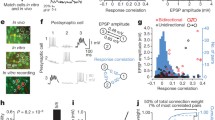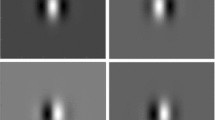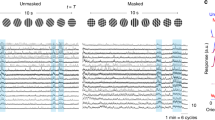Abstract.
Recent experimental studies on the primary visual cortex have revealed complicated nonclassical neuronal activities. Contextual modulation on orientation-contrast is one typical example of nonclassical neuronal behavior. This modulation by surrounding stimuli in a nonclassical receptive field is mainly thought to be mediated by short- and long-range horizontal connections within the primary visual cortex. Short-range connections are circularly symmetrical and relatively independent of orientation preferences, while long-range connections are patchy, asymmetrical, and orientation specific. Although this modulation can be explained by long-range specific connections qualitatively, recent studies suggest that long-range connections alone may be insufficient with respect to the balance between two types of connections. Here, in order to clarify the role of short-range connections in the process of contextual modulation, we propose a model of the primary visual cortex with isotropic short-range connections and a geometric orientation map. Computational simulations using the model have demonstrated that contextual modulation can be explained by short-range connections alone. This is due to the interaction between the spatial periodicity of orientation domains and the excitatory-inhibitory regions arising from the propagation of activities.
Similar content being viewed by others
References
Anderson J, Lampl I, Reichova I, Carandini M, Ferster D (2000) Stimulus dependence of two-state fluctuations of membrane potential in cat visual cortex. Nat Neurosci 3:617–621
Bartfeld E, Grinvald A (1992) Relationships between orientation-preference pinwheels cytochrome oxidase blobs and ocular-dominance columns in primate striate cortex. Proc Natl Acad Sci USA 89:11905–11909
Blasdel GG (1992) Orientation selectivity preference and continuity in monkey striate cortex. J Neurosci 12:3139–3161
Blasdel GG, Salama G (1986) Voltage-sensitive dyes reveal a modular organization in monkey striate cortex. Nature 321:579–585
Bonhoeffer T, Grinvald A (1991) Iso-orientation domains in cat visual cortex are arranged in pinwheel-like patterns. Nature 353:429–431
Bonhoeffer T, Grinvald A (1993) The layout of iso-orientation domains in area 18 of cat visual cortex: optical imaging reveals a pinwheel-like organization. J Neurosci 13:4157–4180
Bosking WH, Zhang Y, Schofield B, Fitzpatrick D (1997) Orientation selectivity and the arrangement of horizontal connections in tree shrew striate cortex. J Neurosci 17:2112–2127
Carandini M, Ferster D (1997) A tonic hyperpolarization underlying contrast adaptation in cat visual cortex. Science 276:949–952
Crair MC, Ruthazer ES, Gillespie DC, Stryker MP (1997) Ocular dominance peaks at pinwheel center singularities of the orientation map in cat visual cortex. J Neurophysiol 77:3381–3385
Das A, Gilbert CD (1999) Topography of contextual modulations mediated by short-range interactions in primary visual cortex. Nature 399:655–661
DeAngelis GC, Freeman RD, Ohzawa I (1994) Length and width tuning of neurons in the cat’s primary visual cortex. J Neurophysiol 71:347–374
Gilbert CD, Wiesel TN (1989) Columnar specificity of intrinsic horizontal and corticocortical connections in cat visual cortex. J Neurosci 9:2432–2442
Hubel DH, Wiesel TN (1977) Ferrier lecture: functional architecture of macaque monkey visual cortex. Proc R Soc Lond B 198:1–59
Hübener M, Bolz J (1992) Relationships between dendritic morphology and cytochrome oxidase compartments in monkey striate cortex. J Comp Neurol 324:67–80
Kapadia MK, Ito M, Gilbert CD, Westheimer G (1995) Improvement in visual sensitivity by changes in local context: parallel studies in human observers and in V1 of alert monkeys. Neuron 15:843–856
Kastner S, Nothdurft HC, Pigarev IN (1997) Neuronal correlates of pop-out in cat striate cortex. Vis Res 37:371–376
Katz LC, Gilbert CD, Wiesel TN (1989) Local circuits and ocular dominance columns in monkey striate cortex. J Neurosci 9:1389–1399
Kisvárday ZF, Tóth É, Rausch M, Eysel UT (1997) Orientation-specific relationship between populations of excitatory and inhibitory lateral connections in the visual cortex of the cat. Cereb Cortex 7:605–618
Knierim JJ, Van Essen DC (1992) Neuronal responses to static texture patterns in area V1 of the alert macaque monkey. J Neurophysiol 67:961–980
Kuroiwa J, Inawashiro S, Miyake S, Aso H (2000) Self-organization of orientation maps in a formal neuron model using a cluster learning rule. Neural Netw 13:31–40
Lamme VAF (1995) The neurophysiology of figure-ground segregation in primary visual cortex. J Neurosci 15:1605–1615
Li CY, Li W (1994) Extensive integration field beyond the classical receptive field of cat’s striate cortical neurons—classification and tuning properties. Vis Res 34:2337–2355
Linsker R (1986) From basic network principles to neural architecture (series). Proc Natl Acad Sci USA 83:7508–7512, 8390–8394, 8779–8783
Livingstone MS, Hubel DH (1984) Anatomy and physiology of a color system in the primate visual cortex. J Neurosci 4:309–356
Malach R (1992) Dendritic sampling across processing streams in monkey striate cortex. J Comp Neurol 315:303–312
Malach R (1994) Cortical colomns as devices for maximizing neuronal diversity. Trends Neurosci 17:101–104
Malach R, Amir Y, Harel M, Grinvald A (1993) Relationship between intrinsic connections and functional architecture revealed by optical imaging and in vivo targeted biocytin injections in primate striate cortex. Proc Natl Acad Sci USA 90:10469–10473
McGuire BA, Gilbert CD, Rivlin PK, Wiesel TN (1991) Targets of horizontal connections in macaque primary visual cortex. J Comp Neurol 305:370–392
Miller KD (1994) A model for the development of simple cell receptive fields and the ordered arrangement of orientation columns through activity-dependent competition between ON- and OFF-center inputs. J Neurosci 14:409–441
Obermayer K, Blasdel GG (1997) Singularities in primate orientation maps. Neural Comput 9:555–575
Obermayer K, Blasdel GG, Schulten K (1992) Statistical-mechanical analysis of self-organization and pattern formation during the development of visual maps. Phys Rev A 45:7568–7589
Pei X, Vidyasagar TR, Voigushev M, Creutzfeldt OD (1994) Receptive field analysis and orientation selectivity of postsynaptic potentials of simple cells in cat visual cortex. J Neurosci 14:7130–7140
Rossi AF, Rittenhouse CD, Paradiso MA (1996) The representation of brightness in primary visual cortex. Science 273:1104–1107
Schwartz O, Simoncelli P (2001) Natural signal statistics and sensory gain control. Nat Neurosci 4:819–825
Sengpiel F, Sen A, Blakemore C (1997) Characteristics of surround inhibition in cat area 17. Exp Brain Res 116:216–228
Sillito AM, Grieve KL, Jones HE, Cudeiro J, Davis J (1995) Visual cortical mechanisms detecting focal orientation discontinuities. Nature 378:492–496
Tanaka S (1990) Theory of self-organization of cortical maps: mathematical framework. Neural Netw 3:625–640
Ts’o DY, Frostig RD, Lieke EE, Grinvald A (1990) Functional organization of primate visual cortex revealed by high resolution optical imaging. Science 249:417–420
Varela JA, Song S, Turrigiano GG, Nelson SB (1999) Differential depression at excitatory and inhibitory synapses in visual cortex. J Neurosci 19:4293–4304
Weliky M, Kandler K, Fitzpatrick D, Katz LC (1995) Patterns of excitation and inhibition evoked by horizontal connections in visual cortex share a common relationship to orientation columns. Neuron 15:541–552
Yoshimura Y, Sato H, Imamura K, Watanabe Y (2000) Properties of hirizontal and vertical inputs to pyramidal cells in the superficial layers of the cat visual cortex. J Neurosci 20:1931–1940
Zetzsche C, Barth E (1990) Fundamental limits of linear filters in the visual processing of two-dimensional signals. Vis Res 30:1111–1117
Zipser K, Lamme VAF, Schiller PH (1996) Contextual modulation in primary visual cortex. J Neurosci 16:7376–7389
Author information
Authors and Affiliations
Corresponding author
Additional information
Acknowledgement We gratefully acknowledge useful conversations with Hiromichi, Sato. The present work was partly supported by Grant-in-Aid for Scientific Research on Priority Areas (C) Advanced Brain Science Project from the Japanese Ministry of Education, Science, Sports, and Culture.
Rights and permissions
About this article
Cite this article
Okamoto, T., Watanabe, M., Aihara, K. et al. An explanation of contextual modulation by short-range isotropic connections and orientation map geometry in the primary visual cortex. Biol. Cybern. 91, 396–407 (2004). https://doi.org/10.1007/s00422-004-0528-9
Received:
Accepted:
Published:
Issue Date:
DOI: https://doi.org/10.1007/s00422-004-0528-9




